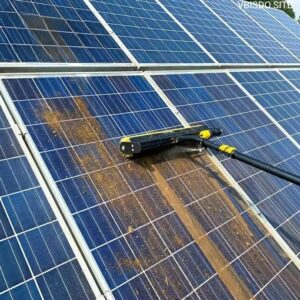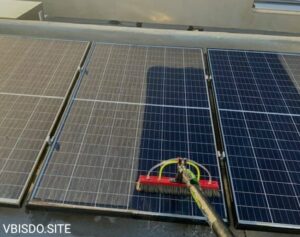As solar energy continues to grow in popularity, homeowners and businesses alike are investing in solar panel systems to reduce energy bills and lower their carbon footprint. While installing solar panels is a smart long-term investment, keeping them clean is essential to maintaining their efficiency.
One question frequently asked is: “How often should I clean my solar panels?” The answer isn’t one-size-fits-all. It depends on factors like location, climate, environmental exposure, and type of solar system.
This guide will explore everything you need to know about how often to clean solar panels, why it matters, signs it’s time for a cleaning, and tips for safe and effective maintenance.
Why Clean Solar Panels Regularly?
Solar panels convert sunlight into electricity, and their surface must remain clear to absorb the maximum amount of solar radiation. Dirt, dust, pollen, bird droppings, and debris can accumulate on the panels, forming a layer that blocks sunlight and reduces system output.
According to the National Renewable Energy Laboratory (NREL), dirty panels can reduce energy output by up to 25% or more in extreme cases.
Key Benefits of Regular Cleaning:
✔️ Maximized energy efficiency
✔️ Extended system lifespan
✔️ Reduced repair and maintenance costs
✔️ Better return on investment
✔️ Maintains warranty conditions (some manufacturers require periodic cleaning)
How Often Should You Clean Solar Panels?
General Recommendation:
Every 6 months to once a year
However, this is just a baseline. The optimal cleaning frequency varies based on local conditions and environmental exposure.
Factors Affecting Cleaning Frequency:
1. Climate and Weather Patterns
Dry, dusty regions (e.g., deserts, arid zones) need more frequent cleaning—possibly every 1 to 3 months.
Rainy climates can self-clean panels, reducing cleaning needs to once a year or less.
Snowy areas may need post-winter cleaning due to grime or residue from melting snow.
2. Nearby Pollution Sources
Proximity to construction zones, highways, factories, or agriculture can increase dust and particulates on your panels.
In such areas, aim for quarterly cleaning (every 3 months).
3. Tilt and Mounting Angle
Panels with a steeper tilt naturally shed debris more effectively.
Flat or low-tilt panels collect more grime and may need cleaning every 2–4 months.
4. Bird Activity
If your roof or area is a hotspot for birds, droppings can significantly impair performance.
In this case, consider inspecting and possibly cleaning every 1 to 2 months.
5. Tree Cover
Trees nearby can drop leaves, pollen, sap, and even shade the panels—causing both dirt and reduced output.
Regular checks every 2 to 3 months are recommended.
Seasonal Cleaning Tips
Each season brings unique challenges:
-
Spring: Pollen, tree sap, and insects may accumulate—clean after heavy pollen seasons.
-
Summer: Dust from dry weather or nearby agriculture—check panels mid-season.
-
Fall: Leaves and debris can collect, especially after storms—clear them regularly.
-
Winter: After snow melts, check for grime or ice damage and schedule a cleaning.
How to Know It’s Time to Clean Your Solar Panels
You don’t always need a calendar reminder—your solar panels will give signs when they need attention:
Signs Your Panels Need Cleaning:
-
Noticeable drop in energy output (monitor system performance)
-
Visible dirt, bird droppings, or leaves
-
Inverter alerts or efficiency warnings
-
After a major weather event (e.g., dust storm, wildfire, heavy rain)
Use your solar monitoring app or dashboard to compare daily and seasonal output. A sharp dip in performance could indicate buildup.
DIY vs. Professional Solar Panel Cleaning
DIY Cleaning
If the panels are safely accessible, you can clean them yourself using:
-
Soft brush or microfiber cloth
-
Hose with gentle water spray
-
Mild soap or solar panel cleaning solution (non-abrasive)
Safety First: Avoid pressure washers, metal tools, or cleaning in extreme heat. Clean in the early morning or late evening when panels are cooler.
Professional Cleaning
For multi-story buildings or hard-to-reach panels, hiring a solar cleaning service is smart. They use specialized tools, water-fed poles, and sometimes robotic cleaners for a thorough job.
Average cost:
$100 to $300 per visit depending on panel number and location
Best Practices for Solar Panel Cleaning
✅ Check with your solar panel manufacturer about cleaning guidelines.
✅ Use deionized water or distilled water for streak-free results.
✅ Don’t walk on panels—this can cause damage or void warranties.
✅ Use safety gear if cleaning on the roof (harness, ladder, gloves).
✅ Schedule cleaning early morning or on cloudy days to prevent thermal shock.
Do Rain and Wind Clean Solar Panels Naturally?
Rain helps rinse away some dirt but is not enough to remove sticky substances like bird droppings, pollen, or pollution residue. In fact, rain can sometimes cause streaking or water spots.
Wind might blow away dry debris, but it can also bring dust that sticks to wet panels after light rain.
So, while natural elements help, relying solely on them is not sufficient for long-term solar performance.
How Long Does a Solar Panel Cleaning Take?
-
DIY cleaning: 30–60 minutes for a small residential system (10–20 panels)
-
Professional service: 1–2 hours with better tools and higher safety
Frequency of cleaning affects time—if you clean panels regularly, the job will be quicker each time.
How Cleaning Frequency Affects Solar Output
Studies show that regularly cleaned solar panels produce up to 20% more energy than neglected ones. This output boost translates to:
-
Faster ROI
-
Lower electricity bills
-
Better sustainability impact
Even a 5% efficiency loss, if left unchecked, could mean hundreds of dollars annually in lost savings for a medium-sized home system.
Should You Automate Solar Panel Cleaning?
If you’re in an extremely dusty or industrial area, automated solar cleaning systems (e.g., robotic wipers or waterless cleaners) are an option. These systems clean without water and can be programmed for daily or weekly use.
They’re more common in commercial solar farms but are becoming available for residential setups too. However, initial investment can be high.
Final Thoughts: Keep It Clean for Long-Term Gains
So, how often should you clean your solar panels? The answer depends on your environment, but as a rule of thumb:
-
Residential users: Every 6–12 months
-
High-dust or industrial areas: Every 1–3 months
-
Heavy pollen or bird activity: Every 1–2 months
Regular maintenance is key to getting the most out of your solar investment. Monitor performance, inspect the panels visually, and either clean them yourself or call a professional when needed.
Keeping your solar panels clean isn’t just good for performance—it’s also good for your wallet and the planet.
SEO Tags Recap:
how often to clean solar panels, solar panel maintenance, solar panel cleaning frequency, rooftop solar cleaning, solar power system care, renewable energy maintenance, solar energy efficiency tips, professional solar panel cleaning

